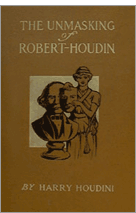|
|
|
|
1910–1924 | 1925–1926 | 1927–1930 | 1931–1943 | MORE RECENT
|
THE NEW YORK TIMES • May 28, 1910 • Page 307, Column 2
|
CONJURING TRICKS REVEALED
 “The Unmasking of Robert Houdin,” by Harry Houdini (E.P. Dutton & Co.) is a new edition, imported from England, of a book which was first put on the market some years ago by an American firm. To the old book, purporting to be an exposition of the fraudulent claims of Robert Houdin, and a redistribution of the honors formerly awarded to that conjuror among such of his predecessors as had anticipated him in his alleged inventions, Mr. Houdini now adds a hundred pages or more explaining the tricks and methods of so-called manacle monarchs, handcuff kings, and jailbreakers who pretend that they are able to release themselves from police regulation handcuffs made in any part of the world. He tells us that he intends no offense to those performers who work on thoroughly legitimate lines (lines, it would appear, which Mr. Harry Houdini himself was the first to lay down), but seeks only to unveil those impostors who evade the critical tests by fraud and colossal lying. He promises at the beginning that he will make startling revelations of the modus operandi of such performers. And, in effect, these revelations may prove sensational to the profession. But as a member of the lay public, the present writer at least must confess that his pulses beat not a whit quicker as trick after trick was brought to his attention. There is a sort of tacit agreement between public and “professor” that the latter may resort to any trickery that is not too obvious. If the illusion be complete what care I if it be or be not accomplished according to orthodox law? “The Unmasking of Robert Houdin,” by Harry Houdini (E.P. Dutton & Co.) is a new edition, imported from England, of a book which was first put on the market some years ago by an American firm. To the old book, purporting to be an exposition of the fraudulent claims of Robert Houdin, and a redistribution of the honors formerly awarded to that conjuror among such of his predecessors as had anticipated him in his alleged inventions, Mr. Houdini now adds a hundred pages or more explaining the tricks and methods of so-called manacle monarchs, handcuff kings, and jailbreakers who pretend that they are able to release themselves from police regulation handcuffs made in any part of the world. He tells us that he intends no offense to those performers who work on thoroughly legitimate lines (lines, it would appear, which Mr. Harry Houdini himself was the first to lay down), but seeks only to unveil those impostors who evade the critical tests by fraud and colossal lying. He promises at the beginning that he will make startling revelations of the modus operandi of such performers. And, in effect, these revelations may prove sensational to the profession. But as a member of the lay public, the present writer at least must confess that his pulses beat not a whit quicker as trick after trick was brought to his attention. There is a sort of tacit agreement between public and “professor” that the latter may resort to any trickery that is not too obvious. If the illusion be complete what care I if it be or be not accomplished according to orthodox law?
 And so, in the same way, though Harry Houdini laments the cruel disillusion he suffered when he discovered that the supposed great original, Robert Houdin, was not as original as he pretended to be that, in fact, he was a purloiner and adapter of other men’s ideas rather than an inventor and a pioneer—he will not be likely to stir the fountain of tears in the ordinary lay breast. One thing, however, our author has accomplished for which we may all be grateful. He has given us a reliable and very interesting history of the gradual evolution of the art of stage magic and its latest development. In the course of his researches, he has gathered together from the [?] block and the old curiosity shop a lot of pictorial material in the shape of old programmes, old prints, and old portraits, and has reproduced a large number of these to illustrate and illuminate his text. The book may be safely recommended to any one who is content to be mildly amused, and who will suffer no great disappointment at missing a promised sensation. And so, in the same way, though Harry Houdini laments the cruel disillusion he suffered when he discovered that the supposed great original, Robert Houdin, was not as original as he pretended to be that, in fact, he was a purloiner and adapter of other men’s ideas rather than an inventor and a pioneer—he will not be likely to stir the fountain of tears in the ordinary lay breast. One thing, however, our author has accomplished for which we may all be grateful. He has given us a reliable and very interesting history of the gradual evolution of the art of stage magic and its latest development. In the course of his researches, he has gathered together from the [?] block and the old curiosity shop a lot of pictorial material in the shape of old programmes, old prints, and old portraits, and has reproduced a large number of these to illustrate and illuminate his text. The book may be safely recommended to any one who is content to be mildly amused, and who will suffer no great disappointment at missing a promised sensation.
This article is reproduced here only for educational purposes. Please do not copy the text or accompanying images for commercial use.
HOME • ABOUT • ARTICLES • LINKS
Back to Top
|
|
